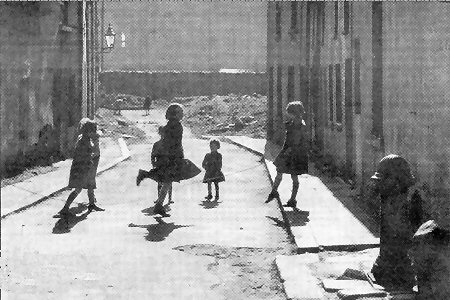I must apologise to our regular contributors – and especially to Martin Payne – whose articles have been sidelined for the duration of the Dr
‘As you enter Brown’s Yard from High Street the first cottage of the row of four is the home of a man called Mr M Teggart. I don’t have a lot of information on this man except that he had the ability … to set a photograph into a frame, and I must say that he made an exceptionally good job of it. Mr Teggart had a relation, a nephew, who was in the photographic business and it was this young man who took the photograph of the young girl in communion dress standing at her door in Brown’s Yard.
At this time (1929) the next two houses in the row were occupied by two sisters, the first of the two sisters was called Catharine. Catharine lived in number two and she was married to a
One interesting thing to be said about this particular cottage, number two, is that before the McDermott’s lived there, the cottage was let out to a man who sadly committed suicide by hanging himself from a rafter on the stairwell. After this sad occurrence the cottage was reputed to have been haunted. Because of this haunted house rumour the landlord, who was called Mr. McKenna, was having a difficult time finding another tenant to take up the tenancy of this reputedly haunted building. Mr and Mrs McDermott needed to find accommodation so they accepted the tenancy of Number 2 Brown’s Yard.
The McDermott’s always maintained that they didn’t mind living in that house. Thomas and Catharine McDermott were a good-living Catholic couple and they always put forward the argument that if you prayed and got a Mass said for the repose of the soul of a lost spirit, then that spirit would never do you any harm, so they weren’t afraid to live in the house that their neighbours claimed was haunted.
‘Well I suppose there might be something to be said about that argument, but I suspect it was the fact that the landlord was willing to give them one month’s free rent that eventually tipped the balance,’ was one uncharitable comment I heard.
Even after almost eighty years the young girl from the photograph can still recall the supposed haunting of that house. She confided,
‘The house was haunted by the spectre of a large black dog that appeared from time to time. Sometimes the dog could be seen sitting on the stairs at a position just under the rafter that was used in the unfortunate suicide. At other times that strange dog would actually jump right over you as you lay in bed.
You couldn’t detect any bad or malignant feelings from any of this dog’s appearances so my Aunt and Uncle always said that it didn’t mean us any harm, it was just a poor lost soul that manifested itself in the guise of a dog so as not to frighten us. My Aunt said that we should pray for it. We did and the prayer must have worked because the dog always went away, for a while, but it did come back from time to time: perhaps the spirit just liked been prayed for’.
Mr and Mrs McKevitt occupied the third cottage of the group of four. They had a large family and as mentioned before Mrs McKevitt was the sister of the good lady who lived next door at number two.
Mr McKevitt, whose name was Michael, was also an ex-service man, a soldier who served in the First World War. He was one of
Mrs McKevitt lived on to a ripe old age, but even she in the end would succumb to the grim reaper and eventually die sometime in the mid nineteen-seventies. Mrs McKevitt would become famous around Newry as one of the last old ladies to wear a shawl. The shawl was presumed to be a very unfashionable garment at that time in the sixties and seventies. The old lady’s daughters would be heard to say to her,
‘Mother! Why don’t you buy yourself a good coat to wear?’
Mrs McKevitt would always reply,
‘It’s a dasint (decent) back that wears the shawl’.
….. final later …….
